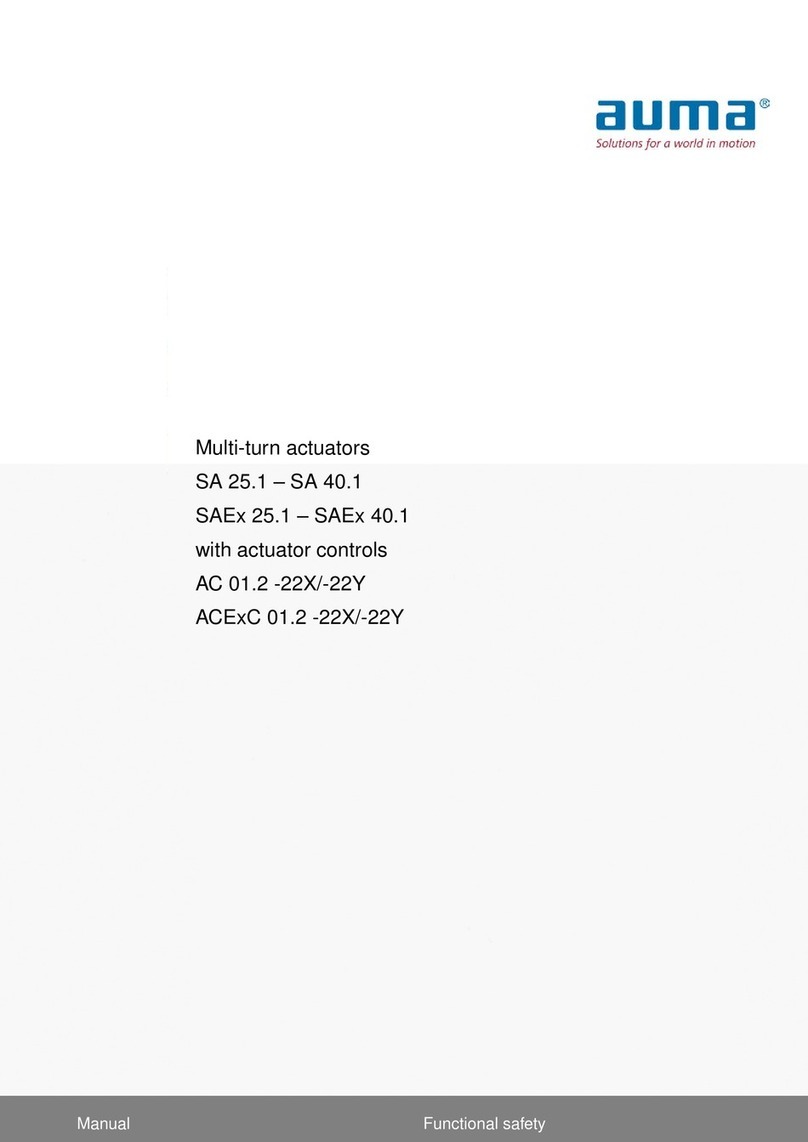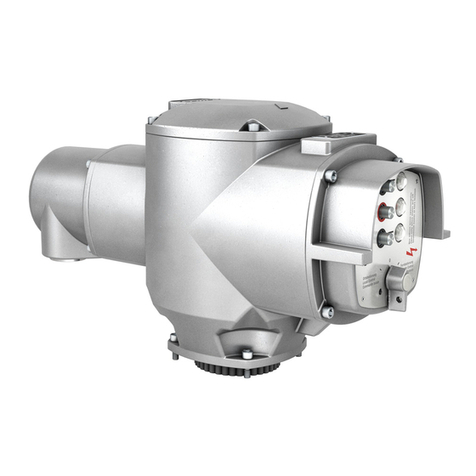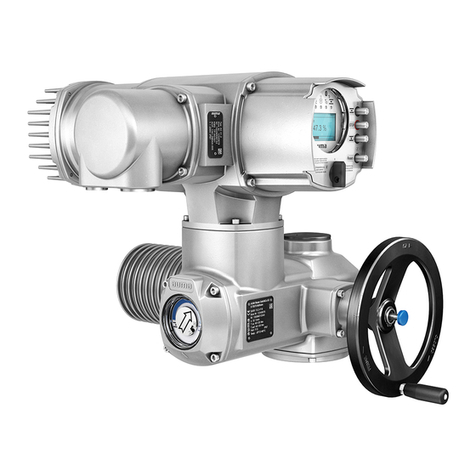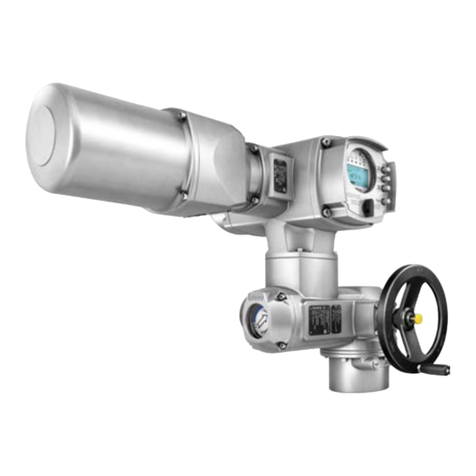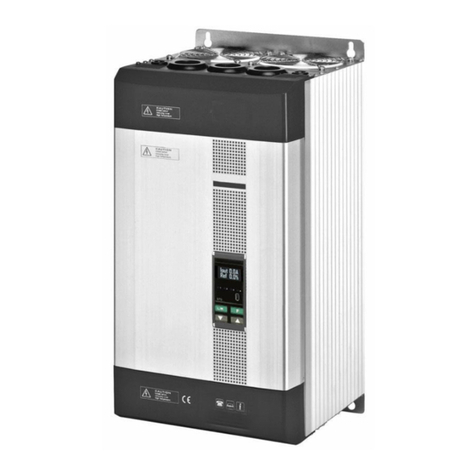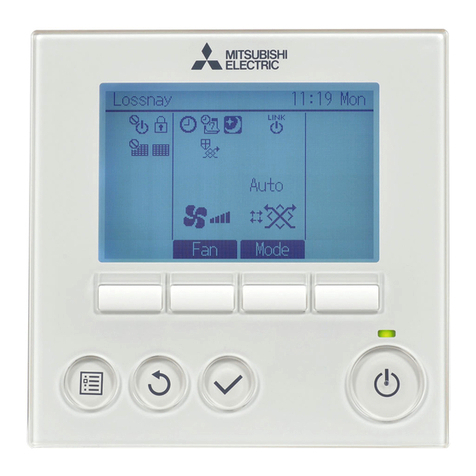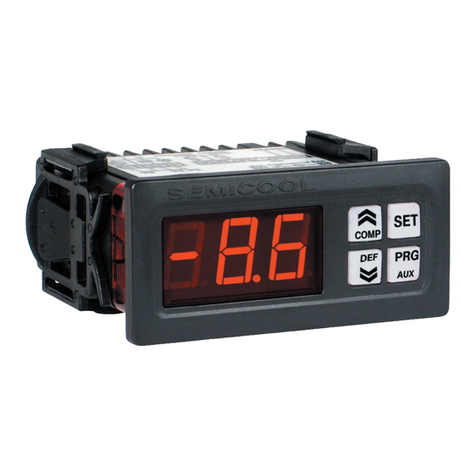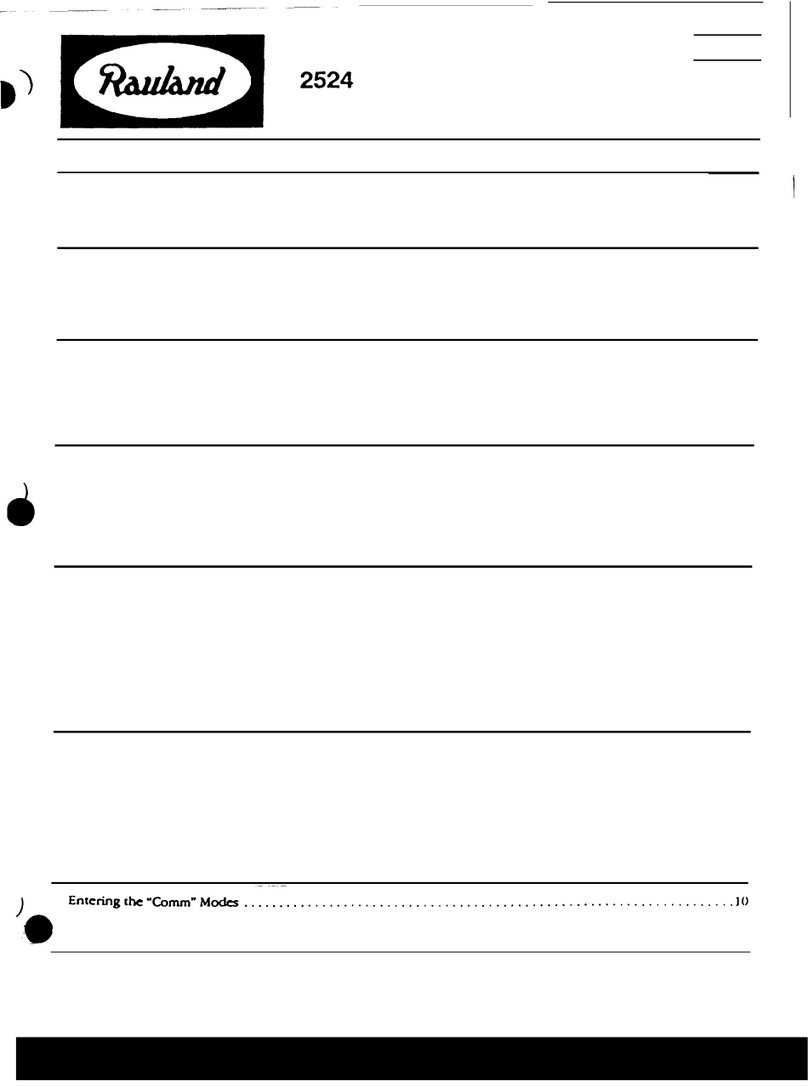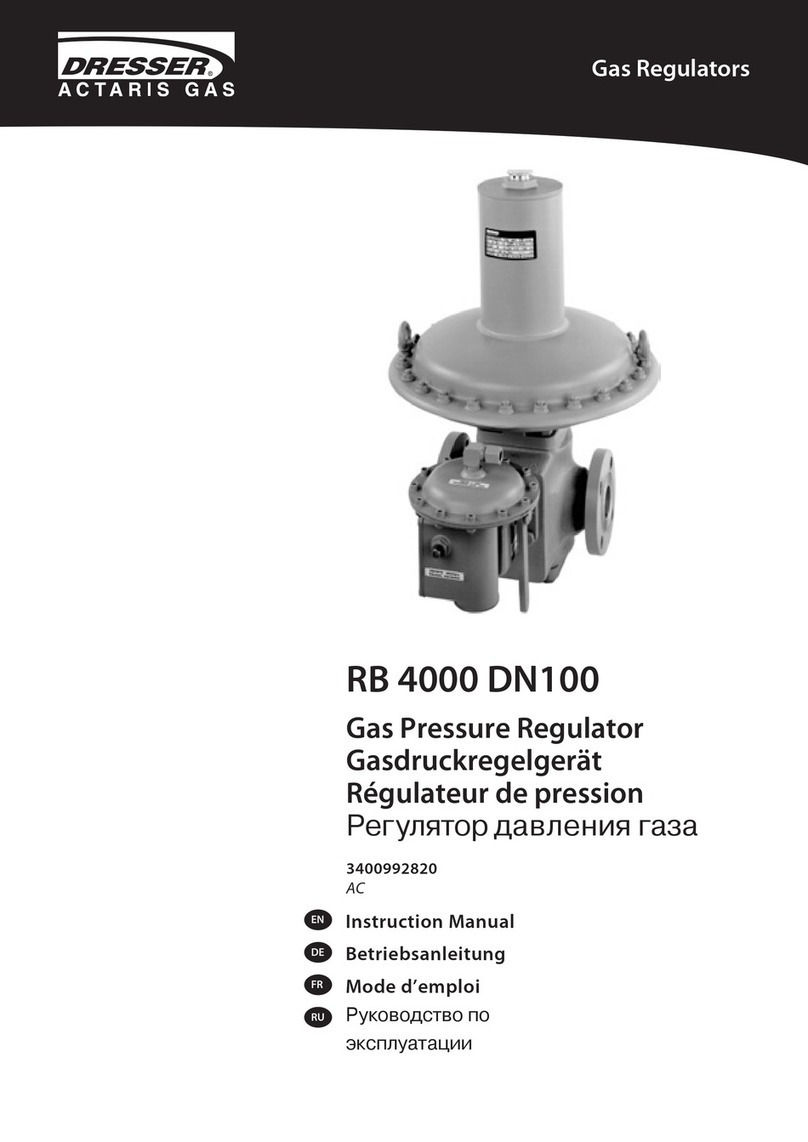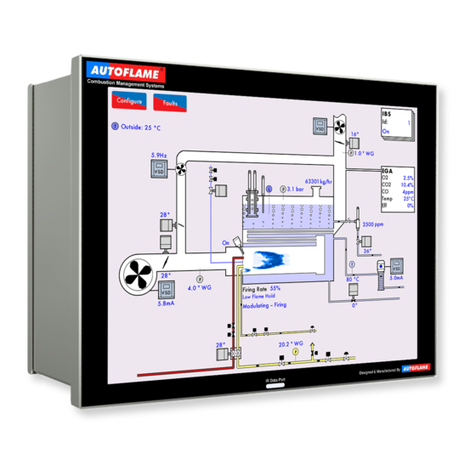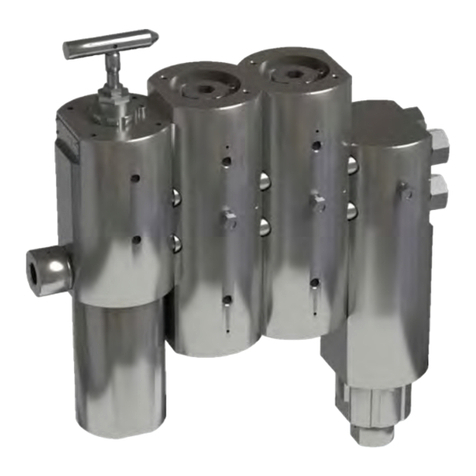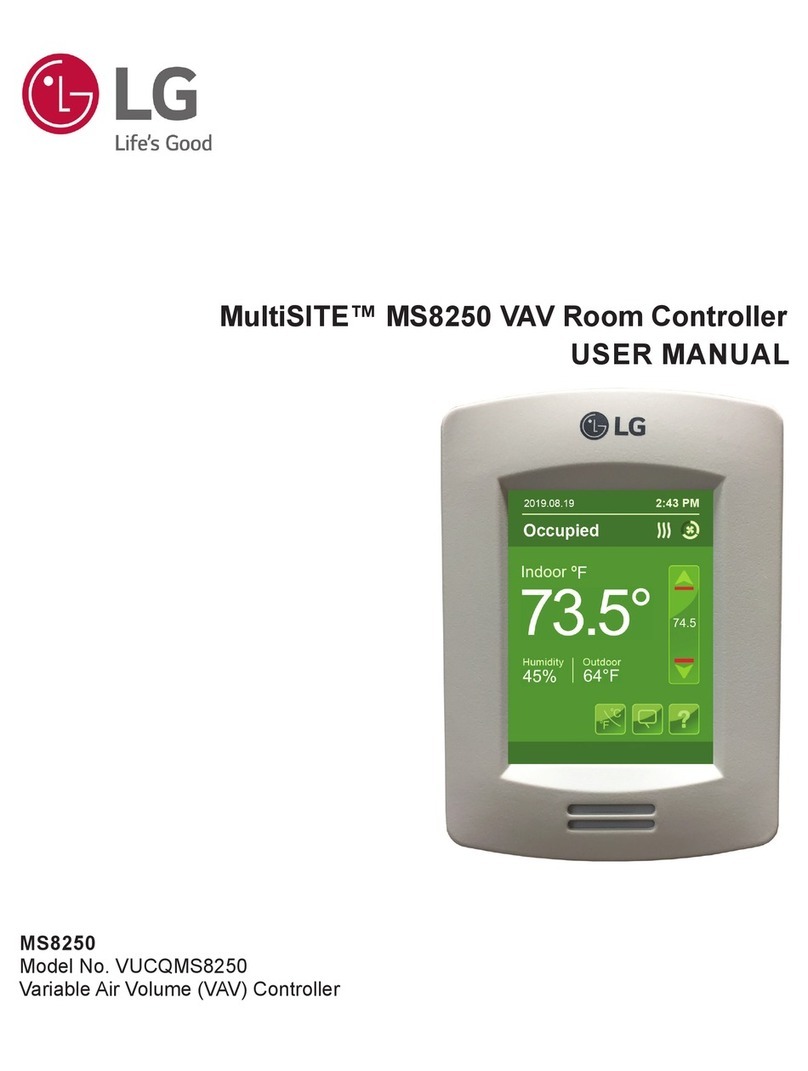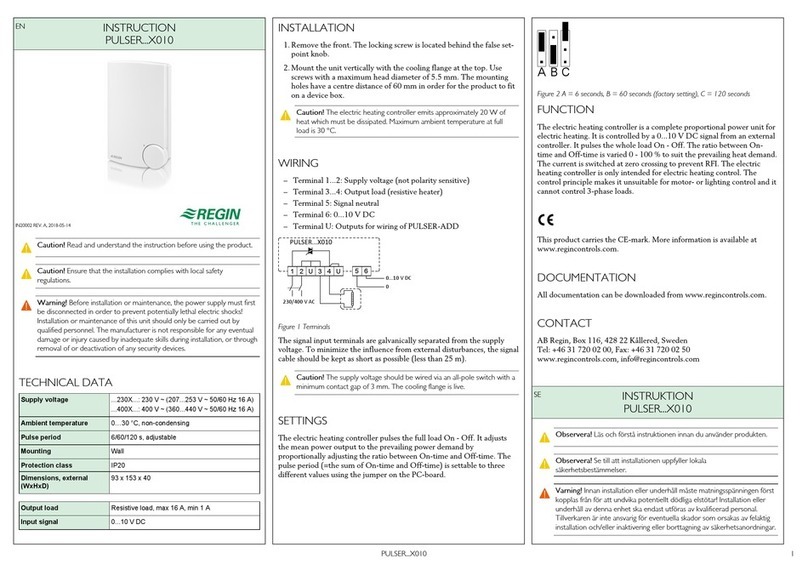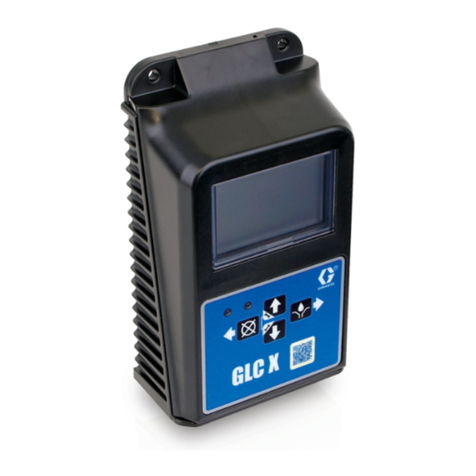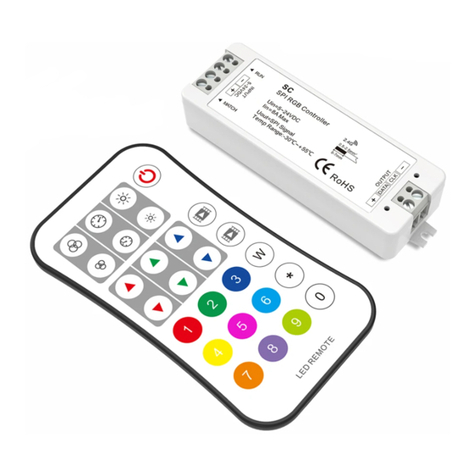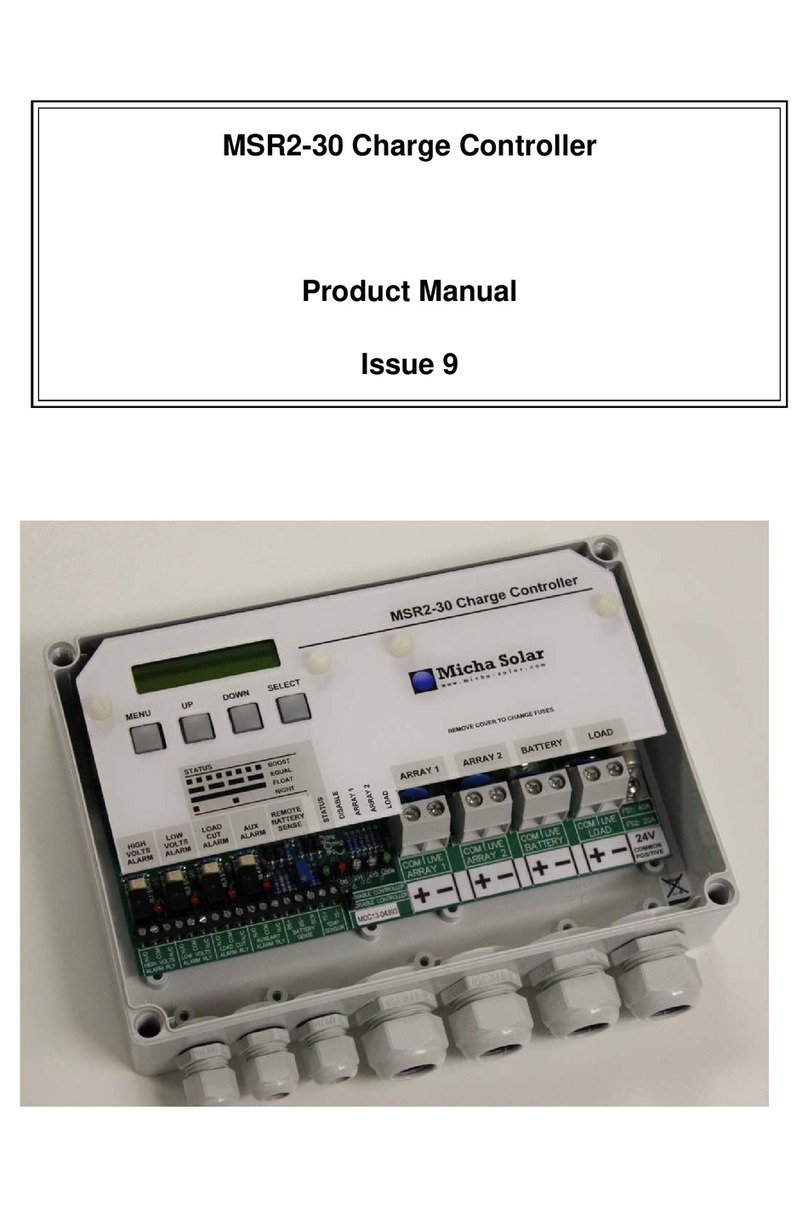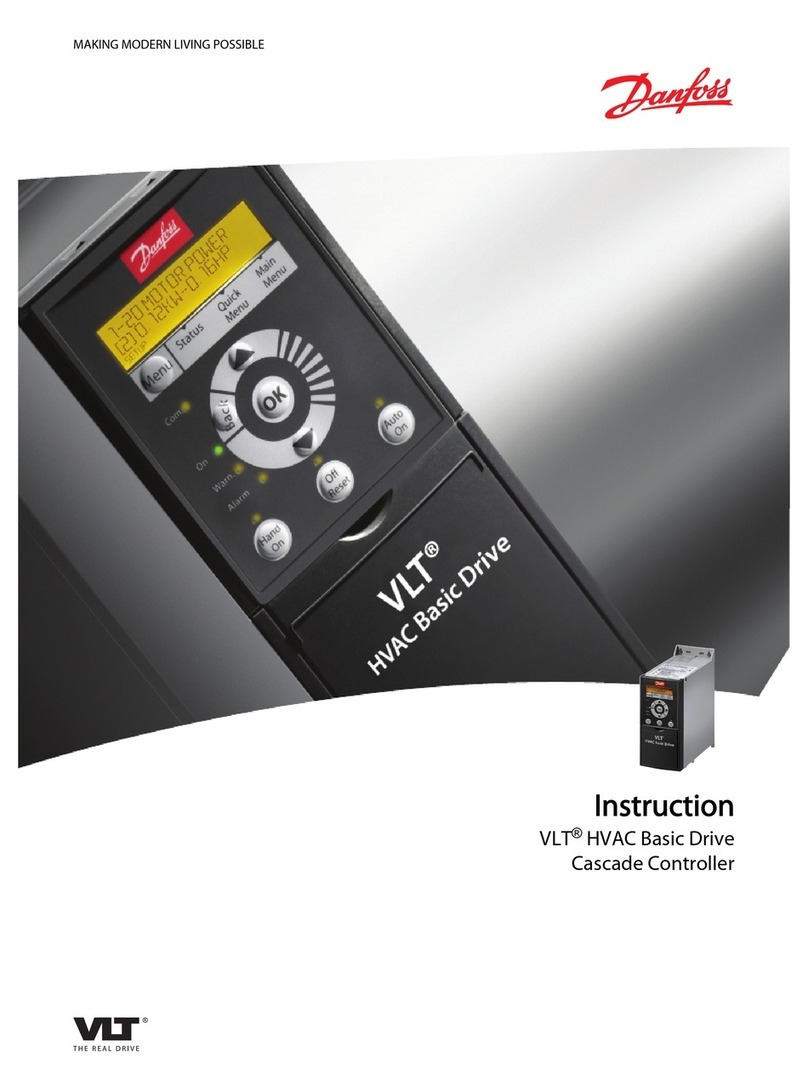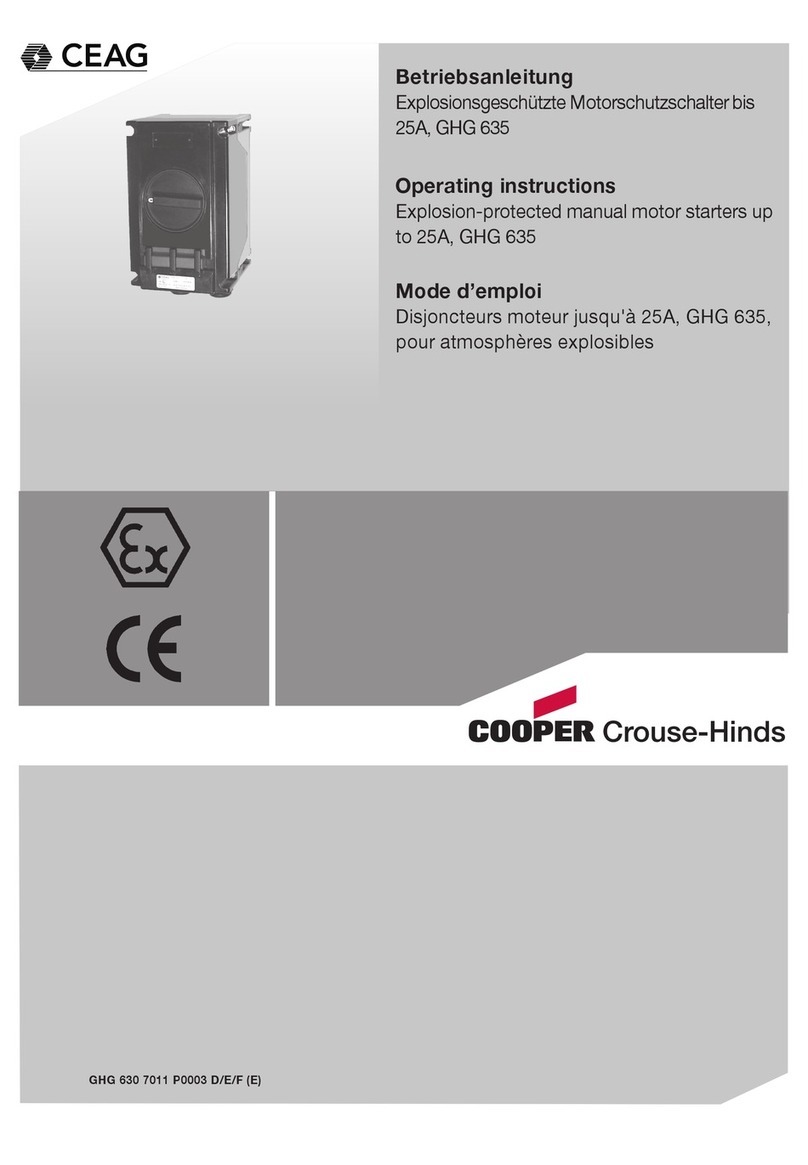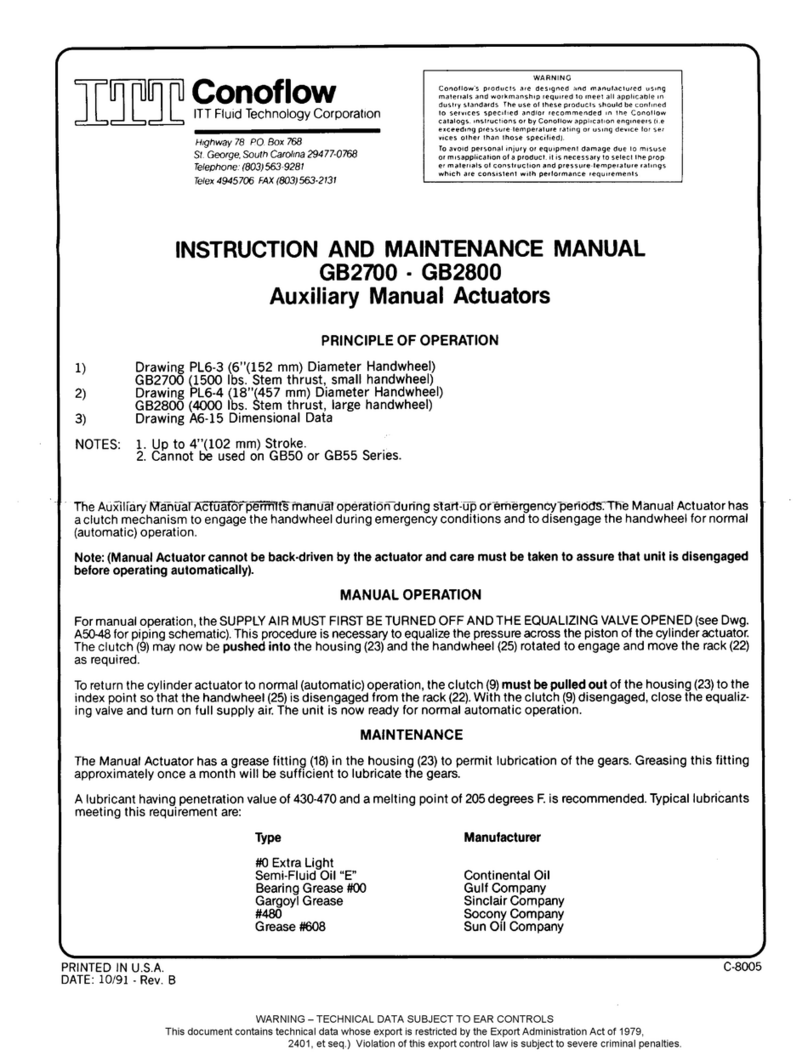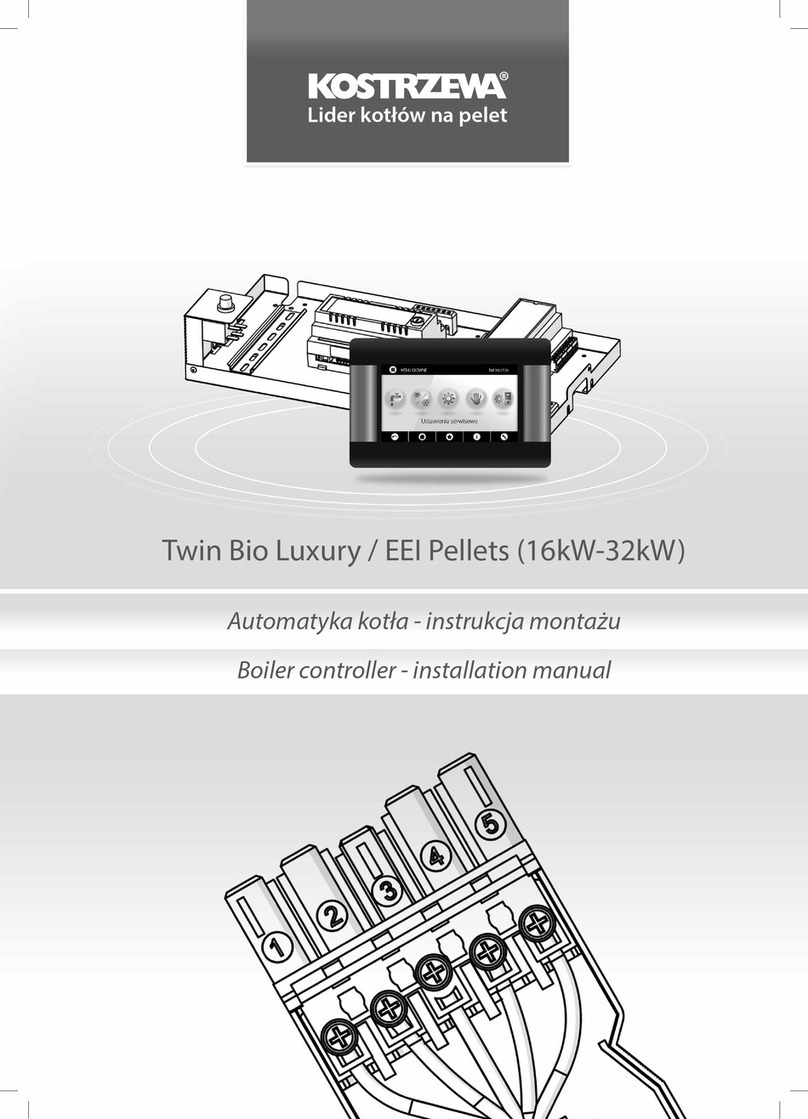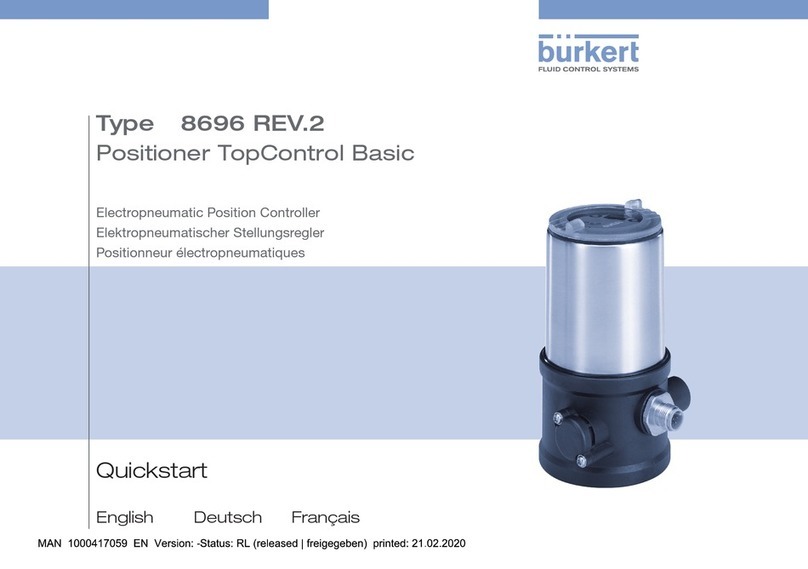AUMA SA 07.2 User manual

Control
Parallel
Profibus DP
Profinet
→Modbus RTU
Modbus TCP/IP
EtherNet/IP
Foundation Fieldbus
HART
Multi-turn actuators
SA 07.2 –SA 16.2
SAR 07.2 –SAR 16.2
Control unit - electromechanical
with actuator controls
AC 01.2 Intrusive
Assembly and commissioningOperation instructions

Read operation instructions first.
●Observe safety instructions.
●These operation instructions are part of the product.
●Store operation instructions during product life.
●Pass on instructions to any subsequent user or owner of the product.
Target group:
This document contains information for assembly, commissioning and maintenance staff.
Reference documents:
●Manual (Operation and setting) of actuator controls AC 01.2 Modbus
●Manual (Fieldbus device integration) of actuator controls AC 01.2 Modbus
Reference documents are available on the Internet at: http://www.auma.com.
Table of contents Page
51. Safety instructions................................................................................................................. 51.1. Prerequisites for the safe handling of the product 51.2. Range of application 61.3. Warnings and notes 61.4. References and symbols
72. Short description...................................................................................................................
93. Name plate..............................................................................................................................
134. Transport and storage........................................................................................................... 134.1. Transport 154.2. Storage
165. Assembly................................................................................................................................ 165.1. Mounting position 165.2. Handwheel fitting 165.3. Mount actuator to valve 175.3.1. Overview of output drive types 175.3.2. Output drive type A 185.3.2.1. Multi-turn actuator with output drive type A:mount 205.3.2.2. Stem nut for output drive type A: finish machining 215.3.3. Output drive types B/C/D and E 225.3.3.1. Multi-turn actuator with output drive type B:mount 235.4. Accessories for assembly 235.4.1. Stem protection tube for rising valve stem 245.5. Mounting positions of local controls 245.5.1. Mounting positions: modify
256. Electrical connection............................................................................................................. 256.1. Basic information 286.2. SD electrical connection (AUMA plug/socket connector) 296.2.1. Terminal compartment (for mains connection): open 306.2.2. Cable connection 316.2.3. Terminal compartment (for mains connection): close 326.2.4. Fieldbus terminal compartment: open
2
SA 07.2 –SA 16.2/SAR 07.2 –SAR 16.2 Control unit - electromechanical
Table of contents AC 01.2 Intrusive Modbus RTU

336.2.5. Fieldbus cables: connect 346.2.6. Fieldbus terminal compartment: close 356.3. Accessories for electrical connection 356.3.1. Actuator controls on wall bracket 366.3.2. Parking frame 366.3.3. DS intermediate frame for double sealing 376.3.4. External earth connection
387. Operation................................................................................................................................ 387.1. Manual operation 387.1.1. Manual valve operation 397.2. Motor operation 397.2.1. Operating the actuator from local controls 407.2.2. Actuator operation from remote 407.3. Menu navigation via push buttons (for settings and indications) 417.3.1. Menu layout and navigation 427.4. User level, password 437.4.1. Password entry 437.4.2. Password change 447.4.3. Timeout for incorrect password entry 447.5. Language in the display 447.5.1. Language change
468. Indications.............................................................................................................................. 468.1. Indications during commissioning 468.2. Indications in the display 478.2.1. Feedback signals from actuator and valve 498.2.2. Status indications according to AUMA classification 508.2.3. Status indications according to NAMUR recommendation 518.3. Indication lights of local controls 528.4. Optional indications 528.4.1. Mechanical position indication via indicator mark
539. Signals (output signals)......................................................................................................... 539.1. Status signals via output contacts (digital outputs) 539.1.1. Assignment of outputs 539.1.2. Coding the outputs 539.2. Analogue signals (analogue outputs)
5410. Commissioning (basic settings)........................................................................................... 5410.1. Type of seating: set 5510.2. Fieldbus address (slave address), baud rate, parity and monitoring time: set 5510.3. Open switch compartment 5610.4. Torque switching: set 5710.5. Limit switching: set 5710.5.1. End position CLOSED (black section): set 5710.5.2. End position OPEN (white section):set 5810.6. Intermediate positions: set 5810.6.1. Running direction CLOSE (black section):set 5910.6.2. Running direction OPEN (white section):set 5910.7. Test run 5910.7.1. Direction of rotation at mechanical position indicator: check 6010.7.2. Direction of rotation at hollow shaft/stem: check
3
SA 07.2 –SA 16.2/SAR 07.2 –SAR 16.2 Control unit - electromechanical
AC 01.2 Intrusive Modbus RTU Table of contents

6110.7.3. Limit switching: check 6110.7.4. Reference operation position feedback: perform 6110.8. Close switch compartment
6311. Commissioning (optional equipment settings)................................................................... 6311.1. EWG 01.1 electronic position transmitter 6411.1.1. Measuring range: set 6511.1.2. Current values : adjust 6511.1.3. LED end position signalling: switch on/off 6511.2. Potentiometer 6611.2.1. Potentiometer: set 6611.3. RWG electronic position transmitter 6711.3.1. Measuring range: set 6711.4. Mechanical position indicator: set
6912. Corrective action.................................................................................................................... 6912.1. Faults during commissioning 6912.2. Fault indications and warning indications 7412.3. Fuses 7412.3.1. Fuses within the actuator controls 7412.3.2. Fuse replacement 7412.3.2.1. Replace fuses F1/F2 7512.3.2.2. Test/replace fuses F3/F4 7512.3.3. Motor protection (thermal monitoring)
7713. Servicing and maintenance................................................................................................... 7713.1. Preventive measures for servicing and safe operation 7813.2. Maintenance 7813.3. Disposal and recycling
7914. Technical data......................................................................................................................... 7914.1. Technical data Multi-turn actuators 8114.2. Technical data Actuator controls 8714.3. Tightening torques for screws
8815. Spare parts............................................................................................................................. 8815.1. Multi-turn actuators SA 07.2 –SA 16.2/SAR 07.2 –SAR 16.2 9015.2. AC 01.2 actuator controls with SD electrical connection
92Index........................................................................................................................................
4
SA 07.2 –SA 16.2/SAR 07.2 –SAR 16.2 Control unit - electromechanical
Table of contents AC 01.2 Intrusive Modbus RTU

1. Safety instructions
1.1. Prerequisites for the safe handling of the product
Standards/directives The end user or the contractor must ensure that all legal requirements, directives,
guidelines, national regulations and recommendations with respect to assembly,
electrical connection, commissioning and operation are met at the place of installation.
They include among others:
●Applicable configuration guidelines for fieldbus applications.
Safety instructions/
warnings All personnel working with this device must be familiar with the safety and warning
instructions in this manual and observe the instructions given. Safety instructions
and warning signs on the device must be observed to avoid personal injury or property
damage.
Qualification of staff Assembly, electrical connection, commissioning, operation, and maintenance must
be carried out by suitably qualified personnel authorised by the end user or contractor
of the plant only.
Prior to working on this product, the staff must have thoroughly read and understood
these instructions and, furthermore, know and observe officially recognised rules
regarding occupational health and safety.
Commissioning Prior to commissioning, imperatively check that all settings meet the requirements
of the application. Incorrect settings might present a danger to the application, e.g.
cause damage to the valve or the installation.The manufacturer will not be held
liable for any consequential damage. Such risk lies entirely with the user.
Operation Prerequisites for safe and smooth operation:
●Correct transport, proper storage, mounting and installation, as well as careful
commissioning.
●Only operate the device if it is in perfect condition while observing these instruc-
tions.
●Immediately report any faults and damage and allow for corrective measures.
●Observe recognised rules for occupational health and safety.
●Observe national regulations.
●During operation,thehousingwarms up and surfacetemperatures>60°Cmay
occur.To prevent possible burns, we recommend checking the surface temper-
ature prior to working on the device using an appropriate thermometer and
wearing protective gloves.
Protective measures The end user or the contractor are responsible for implementing required protective
measures on site, such as enclosures, barriers, or personal protective equipment
for the staff.
Maintenance To ensure safe device operation, the maintenance instructions included in this manual
must be observed.
Any device modification requires prior written consent of the manufacturer.
1.2. Range of application
AUMA multi-turn actuators SA 07.2 –SA 16.2/SAR 07.2 –SAR 16.2 are designed
for the operation of industrial valves, e.g.globe valves, gate valves, butterfly valves,
and ball valves.
Other applications require explicit (written) confirmation by the manufacturer.
The following applications are not permitted, e.g.:
●Industrial trucks according to EN ISO 3691
●Lifting appliances according to EN 14502
●Passenger lifts according to DIN 15306 and 15309
5
SA 07.2 –SA 16.2/SAR 07.2 –SAR 16.2 Control unit - electromechanical
AC 01.2 Intrusive Modbus RTU Safety instructions

●Service lifts according to EN 81-1/A1
●Escalators
●Continuous duty
●Buried service
●Continuous underwater use (observe enclosure protection)
●Potentially explosive areas
●Radiation exposed areas in nuclear power plants
No liability can be assumed for inappropriate or unintended use.
Observance of these operation instructions is considered as part of the device's
designated use.
Information These operation instructions are only valid for the "clockwise closing" standard
version, i.e. driven shaft turns clockwise to close the valve.
1.3. Warnings and notes
The following warnings draw special attention to safety-relevant procedures in these
operation instructions, each marked by the appropriate signal word (DANGER,
WARNING, CAUTION, NOTICE).
Indicates an imminently hazardous situation with a high level of risk. Failure
to observe this warning results in death or serious injury.
Indicates a potentially hazardous situation with a medium level of risk.Failure
to observe this warning could result in death or serious injury.
Indicates a potentially hazardous situation with a low level of risk. Failure to
observe this warning could result in minor or moderate injury. May also be
used with property damage.
Potentially hazardous situation. Failure to observe this warning could result
in property damage. Is not used for personal injury.
Safety alert symbol warns of a potential personal injury hazard.
The signal word (here: DANGER) indicates the level of hazard.
1.4. References and symbols
The following references and symbols are used in these instructions:
Information The term Information preceding the text indicates important notes and information.
Symbol for CLOSED (valve closed)
Symbol for OPEN (valve open)
Via the menu to parameter
Describes the menu path to the parameter.When using the push buttons of local
controls, the required parameter can be quickly found on the display. Display texts
are shaded in grey: Display.
➥Result of a process step
Describes the result of a preceding process step.
6
SA 07.2 –SA 16.2/SAR 07.2 –SAR 16.2 Control unit - electromechanical
Safety instructions AC 01.2 Intrusive Modbus RTU

2. Short description
Multi-turn actuator Definition in compliance with EN 15714-2/EN ISO 5210:
A multi-turn actuator is an actuator which transmits torque to a valve for at least one
full revolution.
AUMA multi-turn actuat-
or Figure 1: AUMA SA 10.2 multi-turn actuator
[1] Multi-turn actuator with motor and handwheel
[2] Actuator controls
[3] Local controls with display, (a) selector switch and (b) push button
[4] Valve connection, e.g. output drive type A
AUMA multi-turn actuators SA 07.2 –SA 16.2/SAR 07.2 –SAR 16.2 are driven by
an electric motor. A handwheel is available for setting and emergency operation.
Switching off in end positions may be either by limit or torque seating.
Actuator controls are required to operate or process the actuator signals.
For non-intrusive version (control unit:electromechanical version), limit and torque
setting is made via switches within the actuator.
For non-intrusive version (control unit:electronic version), limit and torque setting is
made via the actuator controls, neither actuator nor the actuator controls housing
have o be opened.For this purpose, the actuator is equipped with an MWG (magnetic
limit and torque transmitter), also capable of supplying analogue torque feedback
signals/torque indication and analogue position feedback signals/position indication
at the actuator controls output.
In combination with output drive type A, the actuator is capable of withstanding thrust.
Actuator controls The actuator controls AC 01.2 may be mounted directly to the actuator or separately
on a wall bracket.
The actuator can be operated via the push buttons on the local controls of the actuator
controls or settings can be made in the actuator controls menu.The display shows
information on the actuator as well as the menu settings.
The functions of the actuator controls include standard valve control in OPEN-CLOSE
duty, positioning, process control, logging of operating data, diagnostic functions
right through control via various interfaces (e.g. fieldbus, Ethernet and HART).
App and software
Using the AUMA CDT software forWindows-based computers (notebooks or tablets)
and the AUMA Assistant App, actuator data can be uploaded and read, settings
can be modified and stored.The connection between computer and AUMA actuator
is established wireless via Bluetooth interface.With the AUMA Cloud, we provide
an interactive platform to collect and assess e.g.detailed device data of all actuators
within a plant.
7
SA 07.2 –SA 16.2/SAR 07.2 –SAR 16.2 Control unit - electromechanical
AC 01.2 Intrusive Modbus RTU Short description

Figure 2: Communication via Bluetooth
AUMA CDT AUMA CDT is a user-friendly setting and operation program for AUMA actuators.
AUMA CDT software can be downloaded free of charge from our website
www.auma.com.
AUMA Cloud
The AUMA Cloud is the driving element of the digital AUMA world, acting as
interactive platform for efficient maintenance of AUMA actuators at moderate cost.
The AUMA Cloud collects all device data of all actuators within one site and provides
a clear overview at a glance. Detailed analysis provides valuable information on
potential maintenance requirements.Additional functions foster smooth asset
management.
AUMA Assistant App
The AUMA Assistant App enables remote setting and remote diagnostics of AUMA
actuators via Bluetooth using either smartphone or tablet.
The AUMA Assistant App can be downloaded free of charge from the Play Store
(Android) or App Store (iOS).
Figure 3: Link to AUMA Assistant App
8
SA 07.2 –SA 16.2/SAR 07.2 –SAR 16.2 Control unit - electromechanical
Short description AC 01.2 Intrusive Modbus RTU

3. Name plate
Figure 4: Arrangement of name plates
[1] Actuator name plate
[2] Actuator controls name plate
[3] Motor name plate
[4] Additional plate, e.g. KKS plate (Power Plant Classification System)
Actuator name plate
Figure 5: Actuator name plate (example)
(= manufacturer logo); (= CE mark)
[1] Name of manufacturer
[2] Address of manufacturer
[3] Type designation
[4] Order number
[5] Serial number
[6] Speed
[7] Torque range in direction CLOSE
[8] Torque range in direction OPEN
[9] Type of lubricant
[10] Permissible ambient temperature
[11] Can be assigned as an option upon customer request
[12] Enclosure protection
[13] Data Matrix code
9
SA 07.2 –SA 16.2/SAR 07.2 –SAR 16.2 Control unit - electromechanical
AC 01.2 Intrusive Modbus RTU Name plate

Actuator controls name plate
Figure 6: Name plate for actuator controls (example)
[1] Type designation
[2] Order number
[3] Serial number
[4] Actuator terminal plan
[5] Actuator controls terminal plan
[6] Mains voltage
[7] AUMA power class for switchgear
[8] Permissible ambient temperature
[9] Enclosure protection
[10] Control
[11] Data Matrix code
Motor name plate
Figure 7: Motor name plate (example)
(= manufacturer logo); (= CE mark)
[1] Motor type
[2] Motor article number
[3] Serial number
[4] Current type, mains voltage
[5] Rated power
[6] Rated current
[7] Type of duty
[8] Enclosure protection
[9] Motor protection (temperature protection)
[10] Insulation class
[11] Speed
[12] Power factor cos phi
[13] Mains frequency
[14] Data Matrix code
10
SA 07.2 –SA 16.2/SAR 07.2 –SAR 16.2 Control unit - electromechanical
Name plate AC 01.2 Intrusive Modbus RTU

Descriptions referring to name plate indications
Type designation Table 1:
Description of type designation (with the example of SA 07.2-F07)
-F1007.2
Type SA = Multi-turn actuators for open-close duty
Type SAR = Multi-turn actuators for modulating duty
Size
These instructions apply to sizes 07.2, 07.6, 10.2, 14.2, 14.6, 16.2
07.2
Flange sizeF10
Table 2:
Description of actuator controls type designation (with the example of AC 01.2)
01.2AC
Type AC = AUMATIC actuator controlsAC
Size 01.201.2
Order number The product can be identified using this number and the technical data as well as
order-related data pertaining to the device can be requested.
Please always state this number for any product inquiries.
On the Internet at http://www.auma.com > Service & Support >myAUMA, we offer
a service allowing authorised users to download order-related documents such as
wiring diagramsand technical data (both in German andEnglish),inspection certificate
and the operation instructions when entering the order number.
Actuator serial number Table 3:
Description of serial number (example of 0520MD12345)
MD123452005
Positions 1+2: Assembly in week = week 0505
Positions 3+4:Year of manufacture = 202020
Internal number for unambiguous product identificationMD12345
Actuator terminal plan Position 9 after TPA: Position transmitter version
0= without position transmitter
A, B, J, K, L, N, R,T = potentiometer
C, D, E, G, H, M, P, S, U = Electronic position transmitter
AUMA power class for
switchgear The switchgear used in the actuator controls (reversing contactors/thyristors) are
classified according to AUMA power classes (e.g.A1, B1, ....).The power class
defines the max. permissible rated power (of the motor) the switchgear has been
designed for.The rated power (nominal power) of the actuator motor is indicated in
kW on the motor name plate.For the assignment of the AUMA power classes to the
nominal power of the motor types, refer to the separate electrical data sheets.
For switchgear without assignment to any power classes, the actuator controls name
plate does not indicate the power class but the max. rated power in kW.
Control Table 4:
Control examples (indications on actuator controls name plate)
DescriptionInput signal
Control vie Modbus RTU interfaceModbus RTU
Control via Modbus RTU interface and control voltage for OPEN-CLOSE
control via digital inputs (OPEN, STOP, CLOSE)
Modbus RTU/24 V DC
11
SA 07.2 –SA 16.2/SAR 07.2 –SAR 16.2 Control unit - electromechanical
AC 01.2 Intrusive Modbus RTU Name plate

Data Matrix code Whenregistered as authoriseduser,youmayuseour AUMA Assistant App to scan
the Data Matrix code and directly access the order-related product documents without
having to enter order number or serial number.
Figure 8: Link to AUMA Assistant App:
For further Service & Support, Software/Apps/...refer to www.auma.com
12
SA 07.2 –SA 16.2/SAR 07.2 –SAR 16.2 Control unit - electromechanical
Name plate AC 01.2 Intrusive Modbus RTU

4. Transport and storage
4.1. Transport
Actuator For transport to place of installation, use sturdy packaging.
Suspended load!
Death or serious injury.
→Do NOT stand below suspended load.
→Attach ropes or hooks for the purpose of lifting by hoist only to housing and NOT
to handwheel.
→Actuators mounted on valves: Attach ropes or hooks for the purpose of lifting
by hoist to valve and NOT to actuator.
→Actuatorsmountedtogearboxes:Attach ropes or hooks forthepurpose of lifting
by hoist only to the gearbox using eyebolts and NOT to the actuator.
→Actuators mounted to controls: Attach ropes or hooks for the purpose of lifting
by hoist only to the actuator and NOT to the controls.
→Respect total weight of combination (actuator, actuator controls, gearbox, valve)
→Secure load against falling down, sliding or tilting.
→Perform lift trial at low height to eliminate any potential danger e.g. by tilting.
Figure 9: Example: Lifting the actuator
Weights Table 5:
Weight for AC 01.2 actuator controls
Weight approx.[kg]with electrical connection type:
7AUMA plug/socket connector with screw-type connection
13
SA 07.2 –SA 16.2/SAR 07.2 –SAR 16.2 Control unit - electromechanical
AC 01.2 Intrusive Modbus RTU Transport and storage

Table 6:
Weights for multi-turn actuators SA 07.2 –SA 16.2 / SAR 07.2 –SAR 16.2
with 3-phase AC motors
Weight2)
Motor type1)
Type designation
Actuator approx. [kg]
19VD...SA 07.2/
SAR 07.2 20AD...
20VD...SA 07.6/
SAR 07.6 21AD...
22VD...SA 10.2/
SAR 10.2 25AD...
44VD...SA 14.2/
SAR 14.2 48AD...
46VD...SA 14.6/
SAR 14.6 53AD...
67VD...SA 16.2/
SAR 16.2 83AD...
Refer to motor name plate1) Indicated weight includes AUMA NORM multi-turn actuator with 3-phase AC motor, electrical con-
nection in standard version, output drive type B1 and handwheel.For other output drive types, heed
additional weights.
2)
Table 7:
Weights for multi-turn actuators SA 07.2 –SA 16.2 / SAR 07.2 –SAR 16.2
With 1-phase AC motors
Weight2)
Motor type1)
Type designation
Actuator approx. [kg]
21VB...SA 07.2/
SAR 07.2 21VE...
28AE...
21VB...SA 07.6/
SAR 07.6 25VE...
28AE...
37AC...
28VE...48-4...SA 10.2/
SAR 10.2 31VE...48-2...
40AC... 56-4...
43AC... 56-2...
59VE...SA 14.2/
SAR 14.2 61VC...
63AC...
63VE...SA 14.6/
SAR 14.6 66VC...
Refer to motor name plate1) Indicated weight includes AUMA NORM multi-turn actuator with 1-phase AC motor, electrical con-
nection in standard version, output drive type B1 and handwheel.For other output drive types, heed
additional weights.
2)
14
SA 07.2 –SA 16.2/SAR 07.2 –SAR 16.2 Control unit - electromechanical
Transport and storage AC 01.2 Intrusive Modbus RTU

Table 8:
Weights for multi-turn actuators SA 07.2 –SA 16.2 / SAR 07.2 –SAR 16.2
With DC motors
Weight2)
Motor type1)
Type designation
Actuator approx. [kg]
29FN... 63-...SA 07.2/
SAR 07.2 32FN... 71-...
30FN... 63-...SA 07.6/
SAR 07.6 44FN... 80-...
33FN... 63-...SA 10.2/
SAR 10.2 36FN... 71-...
56FN... 90-...
68FN... 71-... / FN... 80-...SA 14.2/
SAR 14.2 100FN... 90-...
76FN... 80-... / FN... 90-...SA 14.6/
SAR 14.6 122FN... 112-...
123FN... 100-...SA 16.2/
SAR 16.2
Refer to motor name plate1) Indicated weight includes AUMA NORM multi-turn actuator with DC motor, electrical connection in
standard version, output drive type B1 and handwheel.For other output drive types, heed additional
weights.
2)
Table 9:
Weights for output drive type
[kg]Flange sizeType designation
1.1F07A 07.2
1.3F10
2.8F10A 10.2
6.8F14A 14.2
11.7F16A 16.2
4.2. Storage
Danger of corrosion due to inappropriate storage!
→Store in a well-ventilated, dry room.
→Protect against floor dampness by storage on a shelf or on a wooden pallet.
→Cover to protect against dust and dirt.
→Apply suitable corrosion protection agent to uncoated surfaces.
Risk of damage due to excessively low temperatures!
→Actuator controls may only be stored permanently down to –30 °C.
→On request, actuators controls may be transported in specific cases and for
short duration at temperatures down to –60 °C.
Long-term storage For long-term storage (more than 6 months), observe the following points:
1. Prior to storage:
Protect uncoated surfaces, in particular the output drive parts and mounting
surface, with long-term corrosion protection agent.
2. At an interval of approx.6 months:
Check for corrosion.If first signs of corrosion show, apply new corrosion protec-
tion.
15
SA 07.2 –SA 16.2/SAR 07.2 –SAR 16.2 Control unit - electromechanical
AC 01.2 Intrusive Modbus RTU Transport and storage

5. Assembly
5.1. Mounting position
When using grease as lubricant, the product described herein can be operated in
any mounting position.
When using oil instead of grease within the actuator gear housing, perpendicular
mounting position is specified whereby the flange is pointing downward.The type of
lubricant used is indicated on the actuator name plate (short designation F...= grease;
O...= oil).
5.2. Handwheel fitting
To avoid transport damage, handwheels are supplied separately as appropriate.In
this instance, the handwheel must be mounted prior to commissioning.
Figure 10: Handwheel
[1] Spacer
[2] Input shaft
[3] Handwheel
[4] Retaining ring
How to proceed 1. If required, fit spacer [1] on input shaft [2].
2. Slip handwheel [3] onto input shaft.
3. Secure handwheel [3] with retaining ring [4].
Information: The retaining ring [4] (together with these operation instructions)
is stored in a weatherproof bag, which is attached to the device prior to delivery.
5.3. Mount actuator to valve
Corrosion due to damage to paint finish and condensation!
→Touch up damage to paint finish after work on the device.
→After mounting, connect the device immediately to electrical mains to ensure
that heater minimises condensation.
16
SA 07.2 –SA 16.2/SAR 07.2 –SAR 16.2 Control unit - electromechanical
Assembly AC 01.2 Intrusive Modbus RTU

5.3.1. Overview of output drive types
Table 10: Overview on output drive types AssemblyDescriptionApplicationValve attachment
➭page 18, Multi-turn actuator with
output drive type A: mount
➭page 17, Output drive type A
●for rising, non-rotating valve stem
●capable of withstanding thrust
●not appropriate for radial forces
A
➭page 22, Multi-turn actuator with
output drive type B: mount
➭page 21, Output drive types B/C/D
and E
●for rotating, non-rising valve stem
●not capable of withstanding thrust
B, B1 –B4
C
D
E
5.3.2. Output drive type A
Figure 11: Output drive type A
[1] Output mounting flange
[2] Stem nut
[3] Valve stem
Short description Output drive type A consisting of output mounting flange [1] with axial bearing stem
nut [2].The stem nut transmits the torque from the actuator hollow shaft to the valve
stem [3]. Output drive type A can withstand thrusts.
To adapt the actuators to available output drive types A with flanges F10 and F14
(year of manufacture 2009 and earlier), an adapter is required.The adapter can be
ordered from AUMA.
17
SA 07.2 –SA 16.2/SAR 07.2 –SAR 16.2 Control unit - electromechanical
AC 01.2 Intrusive Modbus RTU Assembly

5.3.2.1. Multi-turn actuator with output drive type A: mount
1. If output drive type A is already mounted to the multi-turn actuator: Loosen
screws [3] and remove output drive type A [2].
Figure 12: Multi-turn actuator with output drive type A
[1] Multi-turn actuator
[2] Output drive type A, from left to right:
with finish-machined, unbored and pilot bore stem nut
[3] Screws to multi-turn actuator
Information For an unbored or pilot bore stem nut, the stem nut must be finish machined prior
to mounting valve stem and prior to performing the following steps.➭page 20, Stem
nut for output drive type A: finish machining
2. Apply a small quantity of grease to the valve stem.
3. Place output drive type A [2] on valve stem and turn until it is [4] flush on the
valve flange.
4. Turn output drive type A [2] until alignment of the fixing holes.
5. Fasten screws [5] between valve and output drive type A [2] without completely
tightening them.
Figure 13:
18
SA 07.2 –SA 16.2/SAR 07.2 –SAR 16.2 Control unit - electromechanical
Assembly AC 01.2 Intrusive Modbus RTU

6. Fit multi-turn actuator on the valve stem so that the stem nut dogs engage into
the output drive sleeve.
Figure 14:
➥The flanges are flush with each other if properly engaged.
7. Adjust multi-turn actuator until alignment of the fixing holes.
8. Fasten multi-turn actuator with screws [3].
9. Fasten screws [3] crosswise with a torque according to table.
Table 11:
Tightening torques for screws
Tightening torque [Nm]Threads
Strength class A2-80/A4–80
24M8
48M10
200M16
392M20
10. Turn multi-turn actuator with handwheel in direction OPEN until valve flange
[4] and output drive type A [2] are firmly placed together.
Figure 15:
11. Tighten screws [5] between valve and output drive type A crosswise applying
a torque according to table.
19
SA 07.2 –SA 16.2/SAR 07.2 –SAR 16.2 Control unit - electromechanical
AC 01.2 Intrusive Modbus RTU Assembly

5.3.2.2. Stem nut for output drive type A: finish machining
This working step is only required if stem nut is supplied unbored or with pilot bore.
Information For exact product version, please refer to the order-related technical data sheet or
the AUMA Assistant App.
Figure 16: Output drive type A
[1] Stem nut
[2] Axial needle roller bearing
[2.1] Axial bearing washer
[2.2] Axial needle roller and cage assembly
[3] Spigot ring
Procedure 1. Remove spigot ring [3] from output drive.
2. Remove stem nut [1] together with axial needle roller bearings [2].
3. Remove axial bearing washers [2.1] and axial needle roller and cage assemblies
[2.2] from stem nut [1].
4. Drill and bore stem nut [1] and cut thread.
5. Clean the machined stem nut [1].
6. Apply sufficient Lithium soap EP multi-purpose grease to axial needle roller and
cage assemblies [2.2] and axial bearing washers [2.1], ensuring that all hollow
spaces are filled with grease.
7. Place greased axial needle roller and cage assemblies [2.2] and axial bearing
washers [2.1] onto stem nut [1].
8. Re-insert stem nut [1] with axial needle roller bearings [2] into output drive.
9. Screw in spigot ring [3] until it is firm against the shoulder.
20
SA 07.2 –SA 16.2/SAR 07.2 –SAR 16.2 Control unit - electromechanical
Assembly AC 01.2 Intrusive Modbus RTU
Other manuals for SA 07.2
5
This manual suits for next models
12
Table of contents
Other AUMA Controllers manuals
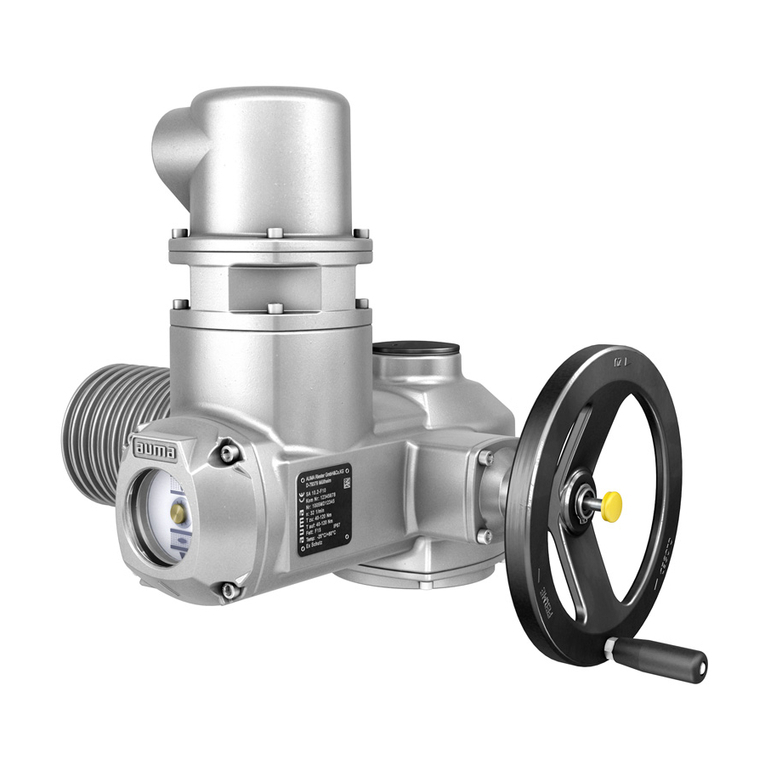
AUMA
AUMA SAEx 07.2 User manual

AUMA
AUMA PROFOX PF-M25 Manual
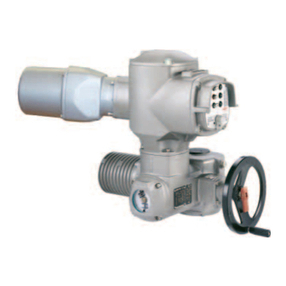
AUMA
AUMA SAExC 07.1 User manual
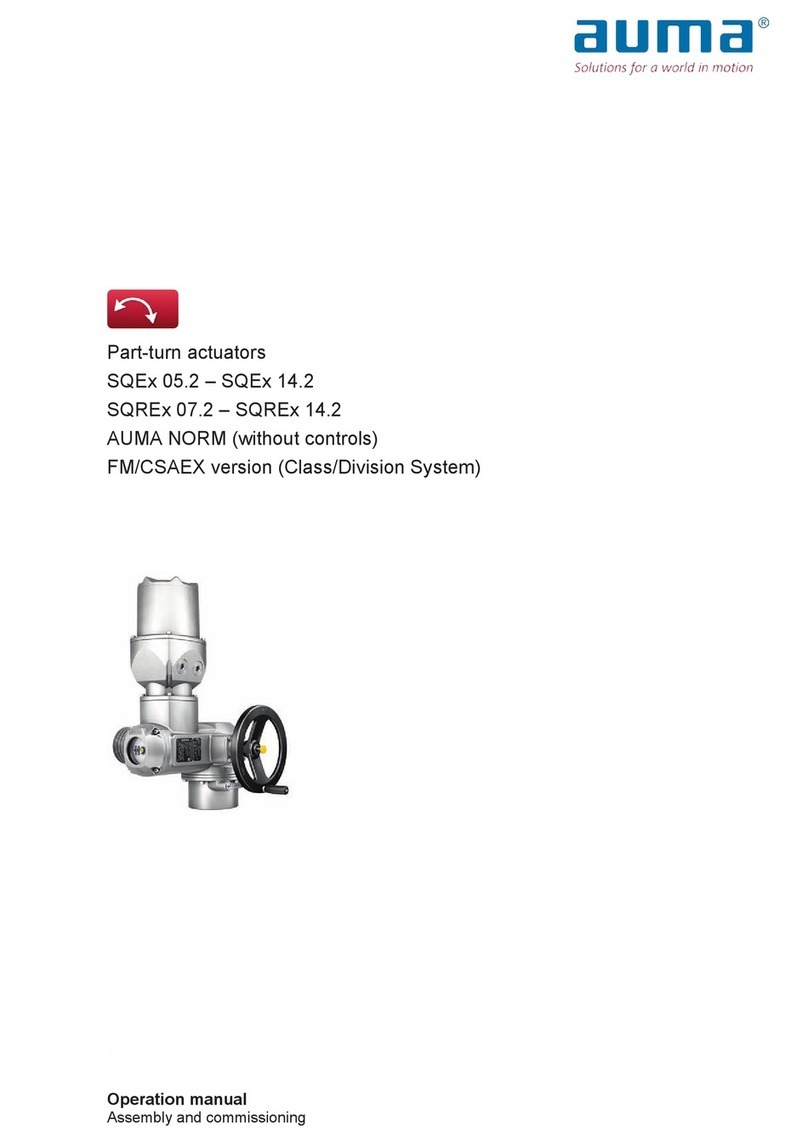
AUMA
AUMA SQEx 05.2 User manual
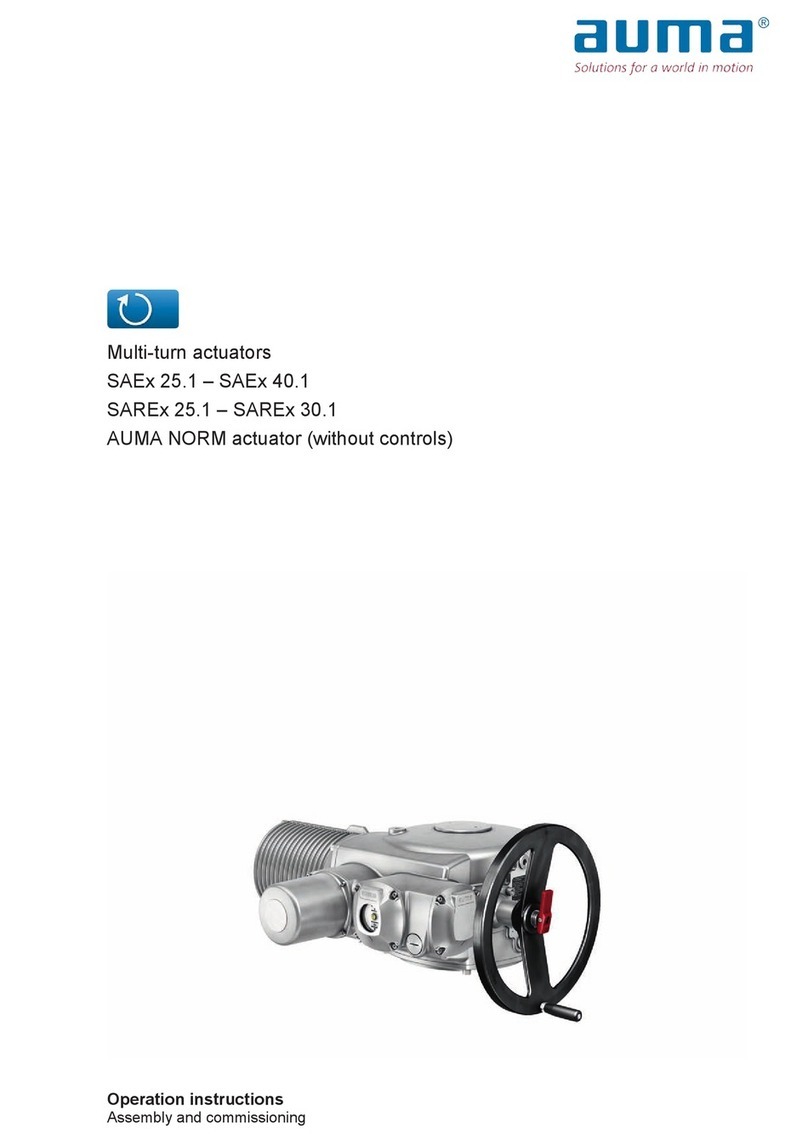
AUMA
AUMA SAEx 25.1 User manual

AUMA
AUMA SAEx 07.2 User manual
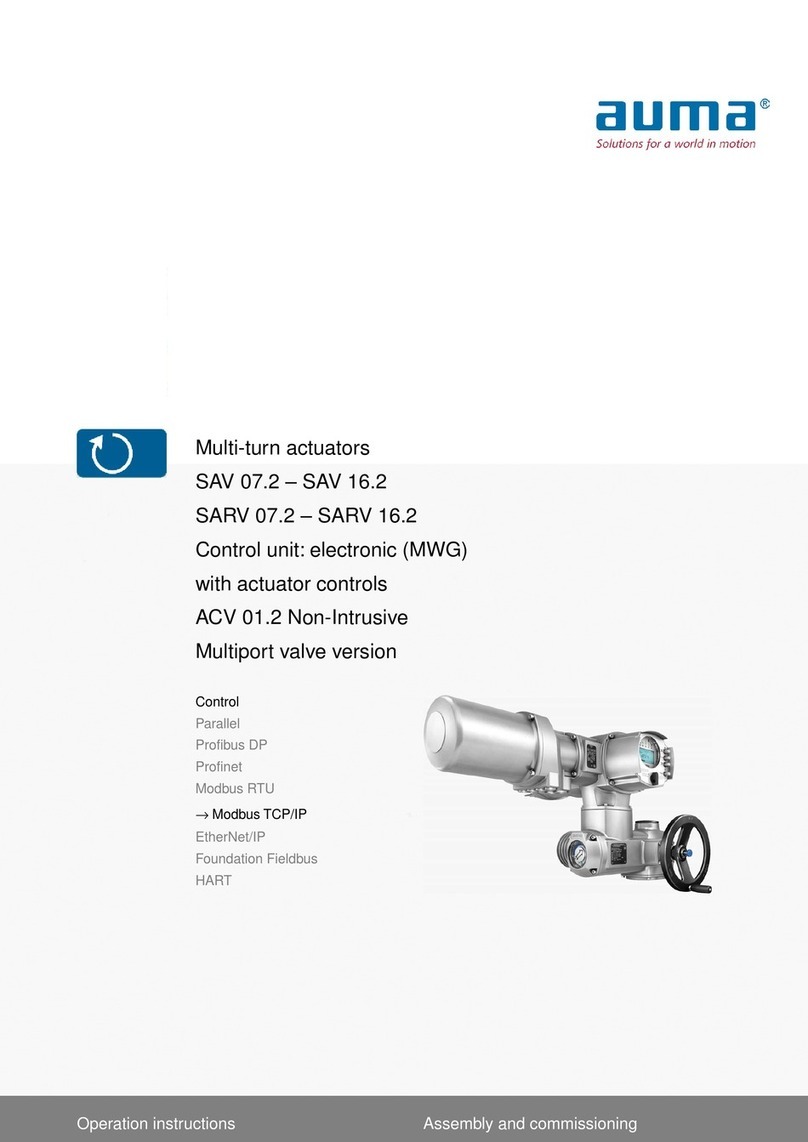
AUMA
AUMA SAV 07.2 User manual
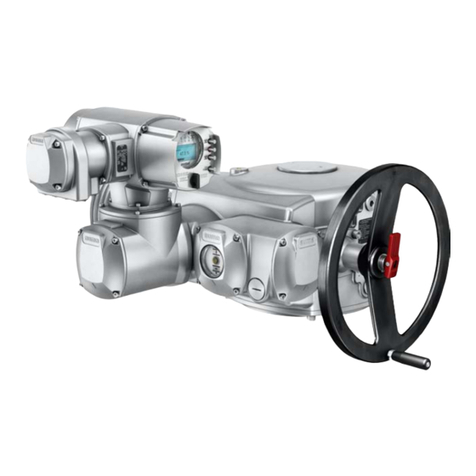
AUMA
AUMA SA 25.1 User manual
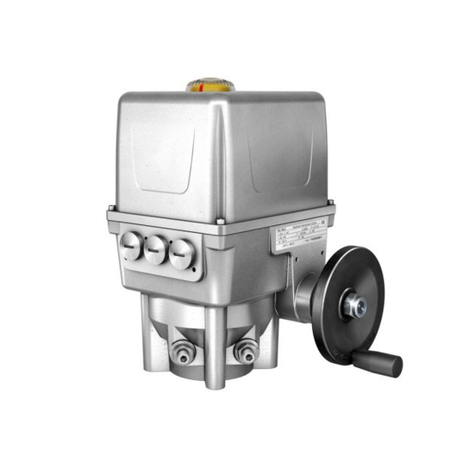
AUMA
AUMA EQ 40 Assembly instructions
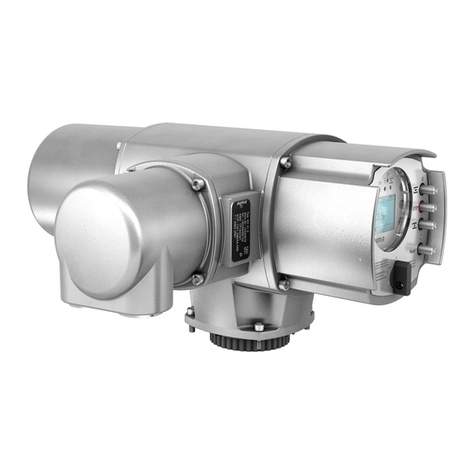
AUMA
AUMA Aumatic AC 01.1 User manual
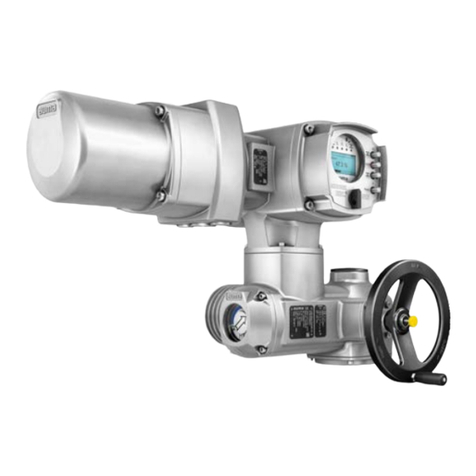
AUMA
AUMA SAEx Series User manual
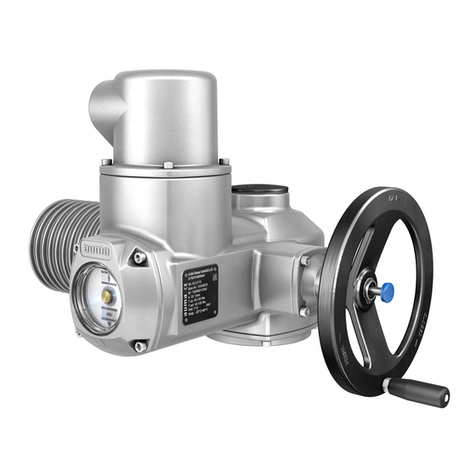
AUMA
AUMA SAM Ex 07.1 User manual
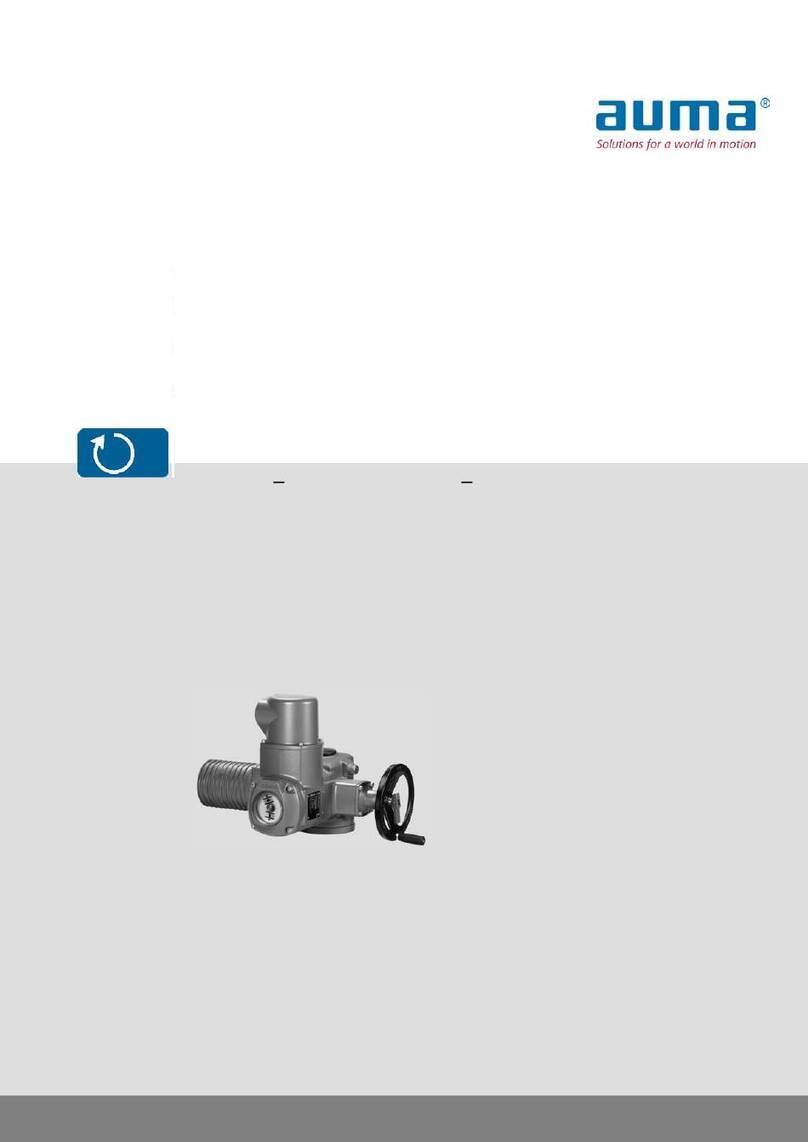
AUMA
AUMA SA 16.1 User manual
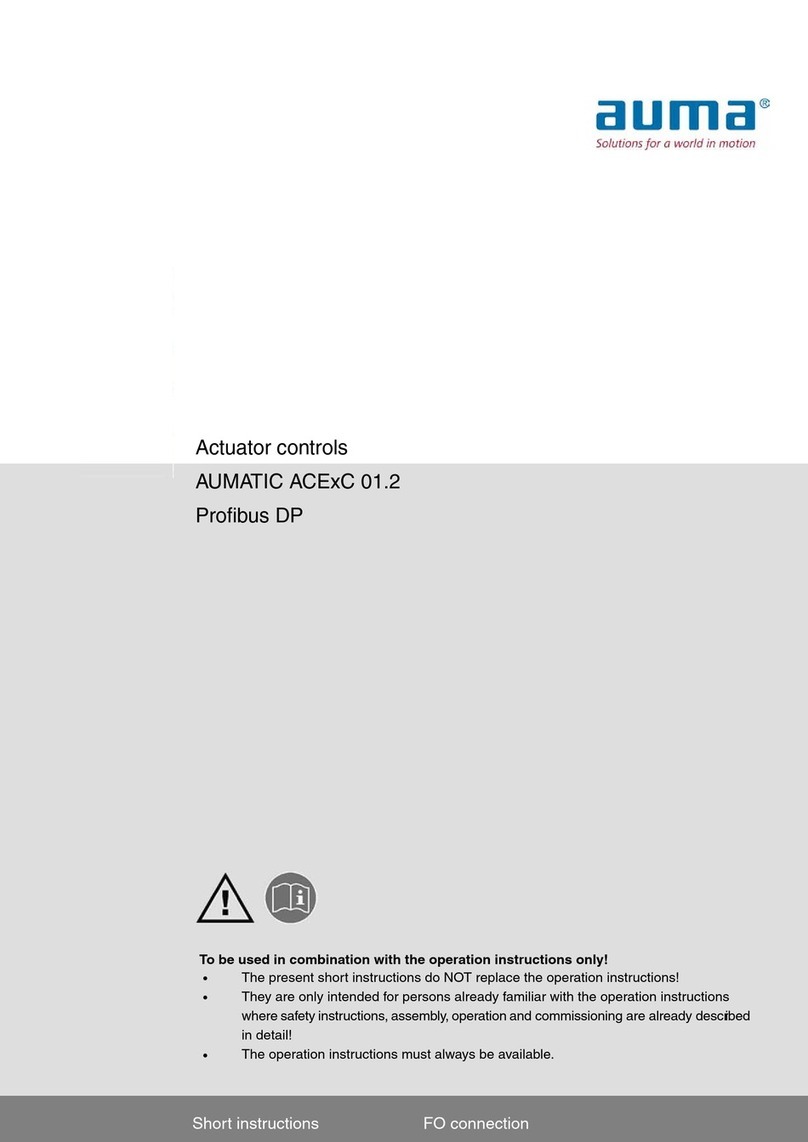
AUMA
AUMA AUMATIC ACExC User manual
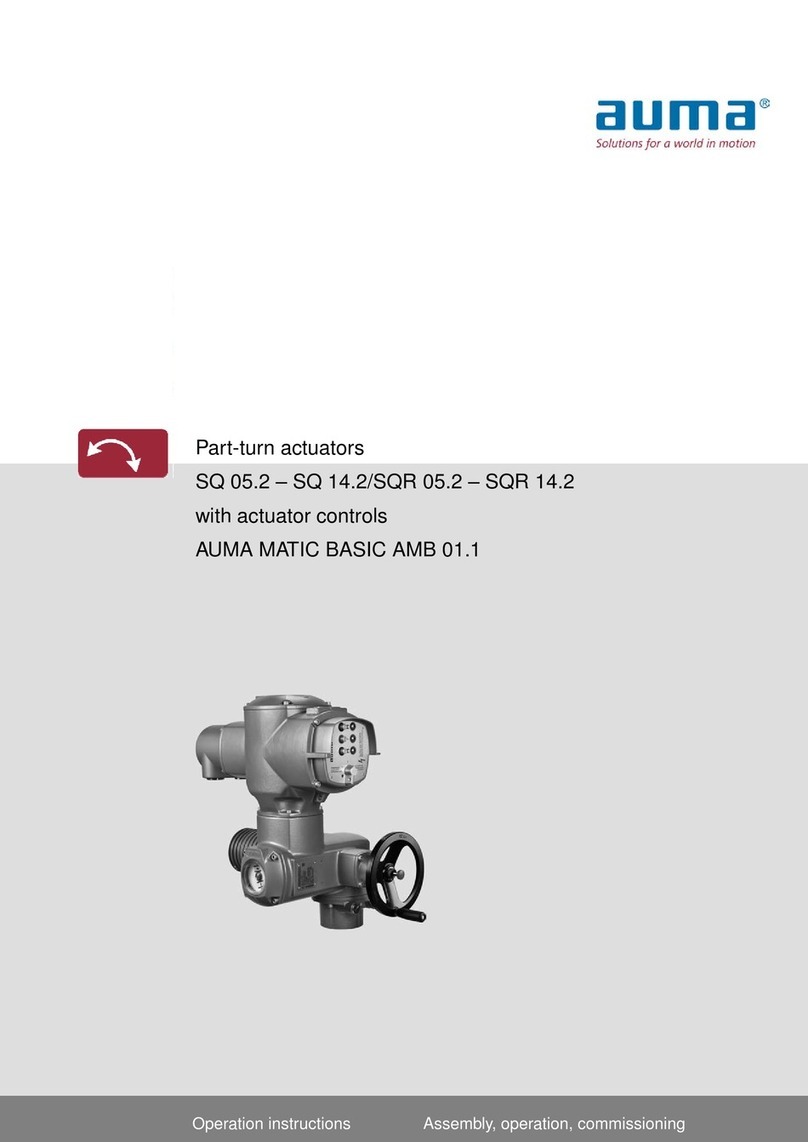
AUMA
AUMA AMB 01.1 User manual

AUMA
AUMA SA 25.1 User manual
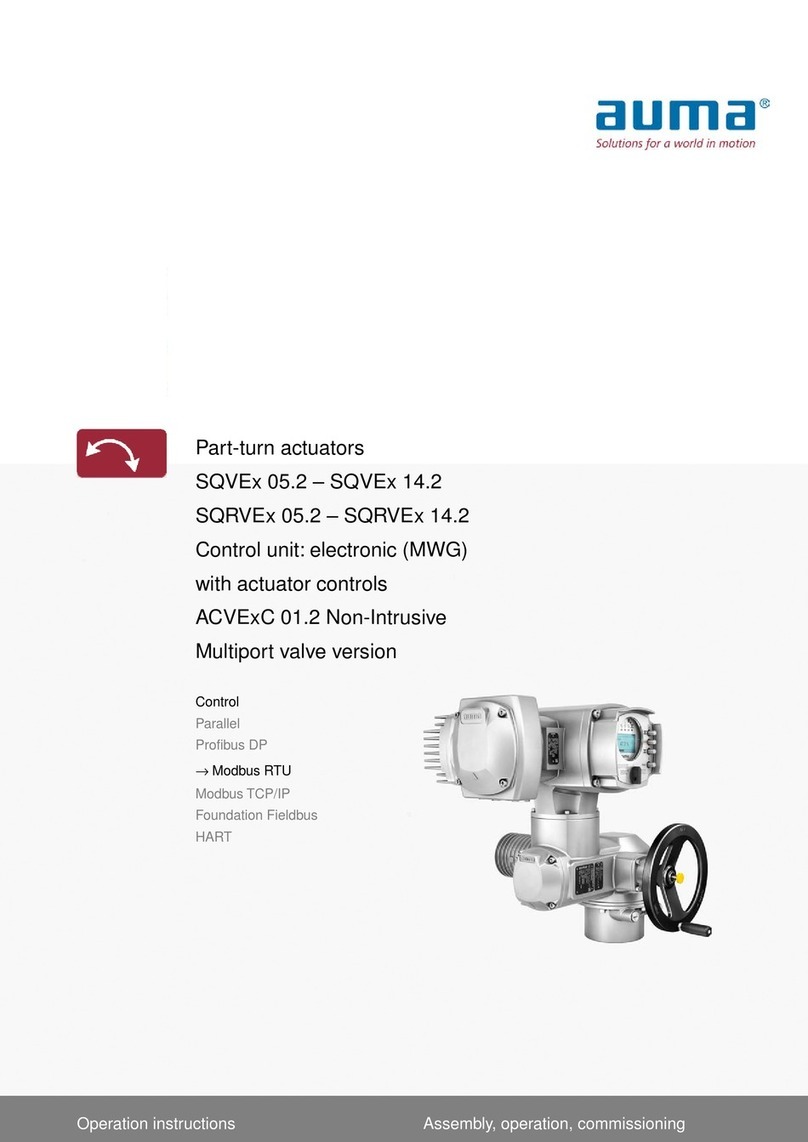
AUMA
AUMA SQVEx 05.2 User manual

AUMA
AUMA SAEx 07.2 User manual
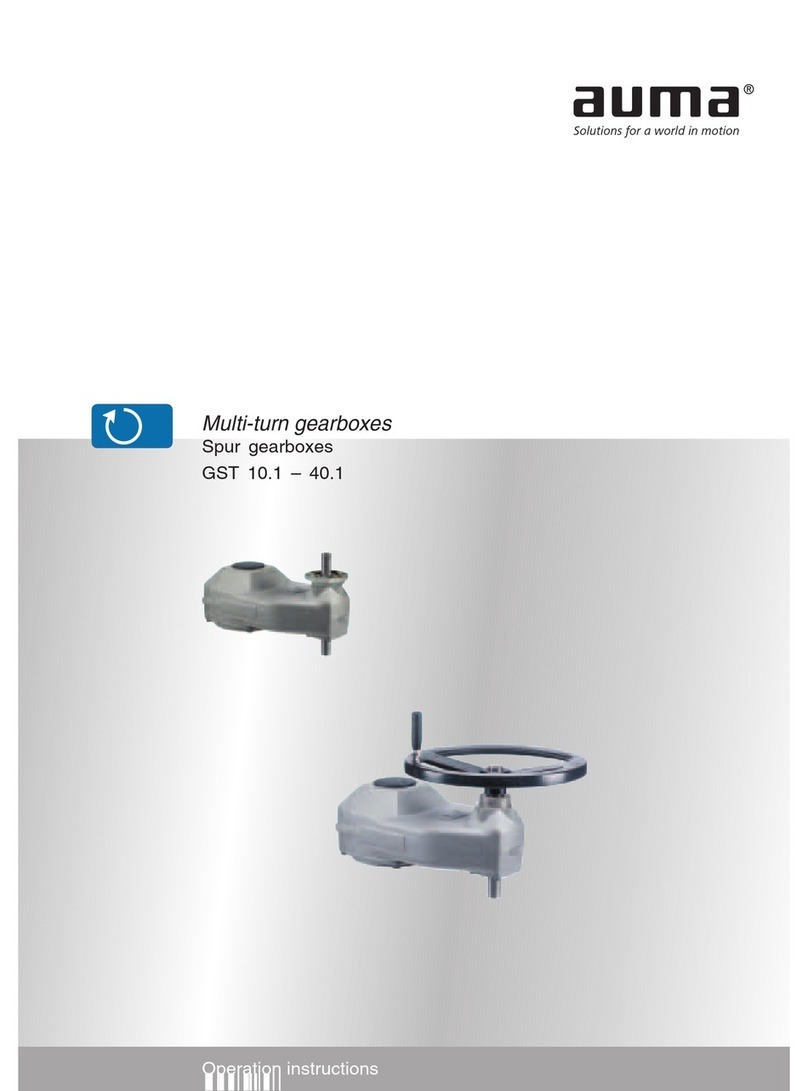
AUMA
AUMA GST 10.1 Administrator Guide
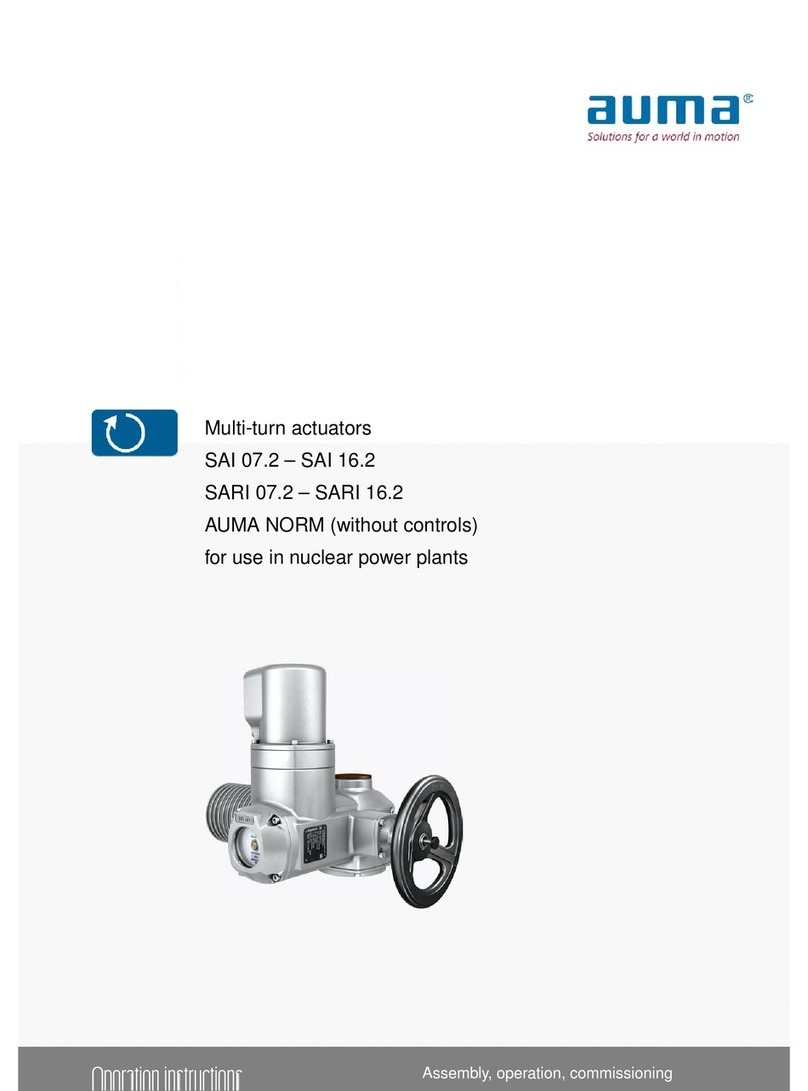
AUMA
AUMA SAI 07.2 User manual
